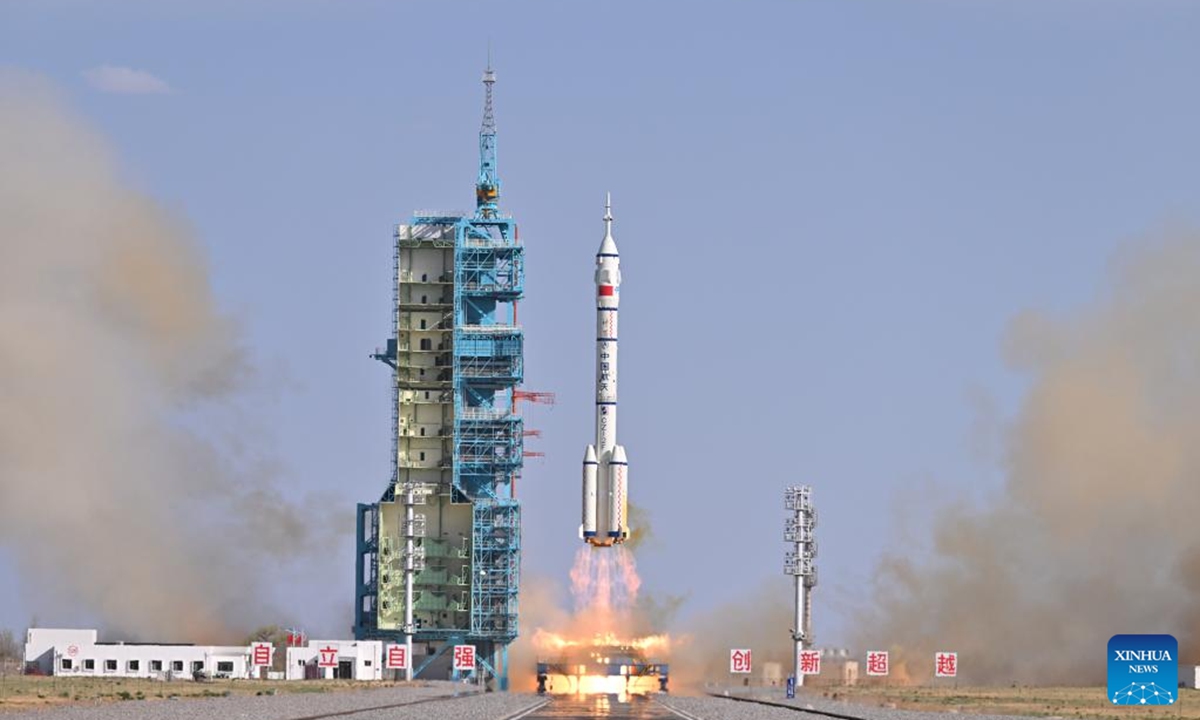
The Shenzhou-20 crewed spaceship, atop a Long March-2F carrier rocket, blasts off from the Jiuquan Satellite Launch Center in northwest China, April 24, 2025. China launched the Shenzhou-20 crewed spaceship on Thursday, sending three astronauts to its orbiting space station for a six-month mission. (Xinhua/Li Xin)
The Shenzhou-20 crewed spaceship blasted off from the Jiuquan Satellite Launch Center in Northwest China, atop the Long March-2F carrier rocket on 5:17 pm on Thursday, carrying taikonauts Chen Dong, Chen Zhongrui and Wang Jie to China's space station.
Following a flight of around 10 minutes, Shenzhou-20 manned spacecraft successfully separated from the rocket and entered its designated orbit.
The launch day of Shenzhou-20 also coincides with China's 10th Space Day. China designated April 24 as its Space Day in 2016 to mark the successful launch of its first satellite, Dongfanghong-1, on April 24, 1970.
The mission's primary objectives include completing an in-orbit rotation with the Shenzhou-19 crew, staying at the space station for approximately six months, carrying out experiments in space science and applications and performing extravehicular activities and cargo in and out tests.
After entering orbit, the Shenzhou-20 spaceship will require about 6.5 hours to perform its automated rendezvous and docking with the radial port of the space station core module Tianhe, thereby forming a combination of three modules and three spacecraft, according to Lin Xiqiang, a spokesperson of the China Manned Space Agency (CMSA), on Wednesday.
Shenzhou-20 is the 35th flight mission of China's manned space program, and the fifth crewed mission during the application and development stage of China's space station. The crew is scheduled to return to the Dongfeng landing site in North China in late October this year.
Technical improvements
As one of the key enhancements of this mission, Long March 2F rocket, which had its maiden flight in 1999, has undergone 32 technical improvements in this mission - ranging from data transmission to flight monitoring, from manufacturing process enhancements to reliability upgrades, the Global Times learned from China Academy of Launch Vehicle Technology.
In this mission, the telemetry system of the Long March-2F rocket uses 5Mbps bitrate transmission technology for the first time, which improves the reliable transmission capability of key data.
In the past, some critical data during the rocket's normal flight had to be stored in a "black box" and retrieved for analysis only after the return capsule landed. Now, with a transmission rate of 5 Mbps, the system can transmit the equivalent of about 100 pages of scanned A4 documents per second, enabling real-time measurement and downlink of flight data throughout the entire mission, according to the academy.
The productized high-definition image measurement scheme was also adopted on the rocket, realizing 100 percent of domestic software and hardware construction and improving the accuracy of real-time judgment of flight status.
With the space station entering regular operation, the Long March 2F rocket will continue to carry out launch missions twice per year. Moving forward, the model team will further enhance work efficiency by focusing on the improvement of digital and information-based tools and methods, providing solid support for the station's sustained operations.
Additionally, during the development of the Shenzhou-20 crewed spacecraft, its payload space was optimized, leading to an increase of approximately 20 percent in available capacity for outbound cargo. This enhancement further boosts the spacecraft's uplink capability, allowing for the delivery of more critical supplies to the space station, the Global Times learned from China Academy of Space Technology.
For this mission, the most notable highlight at the launch site is collecting data with cameras and sensors on the tower and some key locations and critical equipment, Lei Fugui from the Jiuquan Satellite Launch Center told the Global Times.
"The backend distributes and processes the data. When the rocket is scheduled to be launched,we can quickly respond to the emergencies, ensuring all tasks can be carried out smoothly," Lei said.
New experimental projects
The initial plan of the mission is to carry out more than 20 new experimental projects in aeromedicine, including research on the digestive system of the human body, micro-ecology and neurocognition, to more accurately establish protection methods against weightlessness, conduct early warning of radiation risks in space, and conduct research on microbial characteristics changes in space, Wang Chunhui from Astronaut Center of China said during a press conference.
Three research objects - zebrafish, planarians, and Streptomyces - will be used in a set of life science experiments in China's space station during the Shenzhou-20 crewed spaceflight mission, as the regeneration experiment of planarian in space is the first of its kind in China.
As China's first space experiment involving planarians, the Shenzhou-20 mission will study the effects of space on planarian regeneration using head, middle and tail segments, with potential applications in addressing space-related health issues and aging on Earth, Cang Huaixing, professor at the Technology and Engineering Center for Space Utilization under the Chinese Academy of Sciences, told the Global Times.
When bisected, each piece of planarians can regenerate muscles, skin, intestines, and even a complete brain. Studying planarians provides valuable insights into how human cells might overcome aging and delay degeneration, Cang said.
Besides, a 30-day experiment involving six adult male zebrafish will be conducted in orbit, Cang added.
By studying the effects of microgravity on protein homeostasis in vertebrates, the research aims to clarify how protein homeostasis regulates bone mass decrease and cardiovascular dysfunction caused by microgravity, and explore protective strategies for future long-term human space missions.
In addition to the three biological experiments mentioned above, 59 space science experiments and technology tests will also be conducted in the fields of space life sciences, microgravity physical sciences, and new space technologies, during the in-orbit period of the Shenzhou-20 crew, the spokesperson Lin introduced.
Breakthroughs are expected in areas including the cultivation of vascularized brain organoid chips, the non-equilibrium dynamics of soft matter, and the space-based preparation of high-temperature superconducting materials.